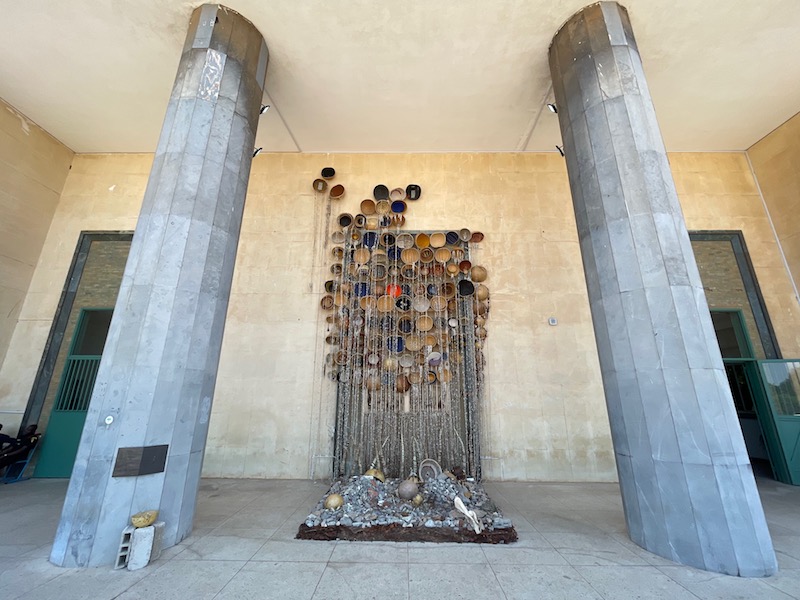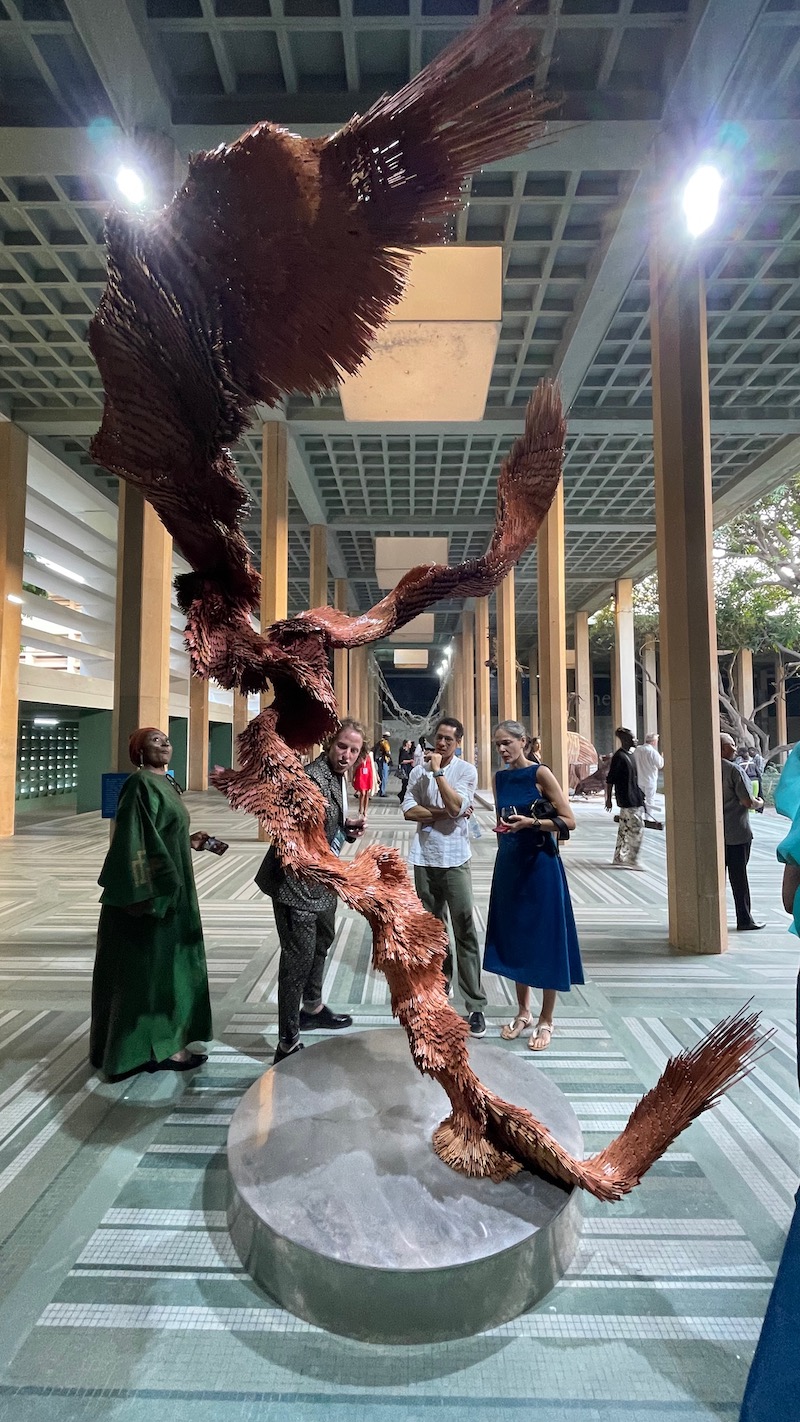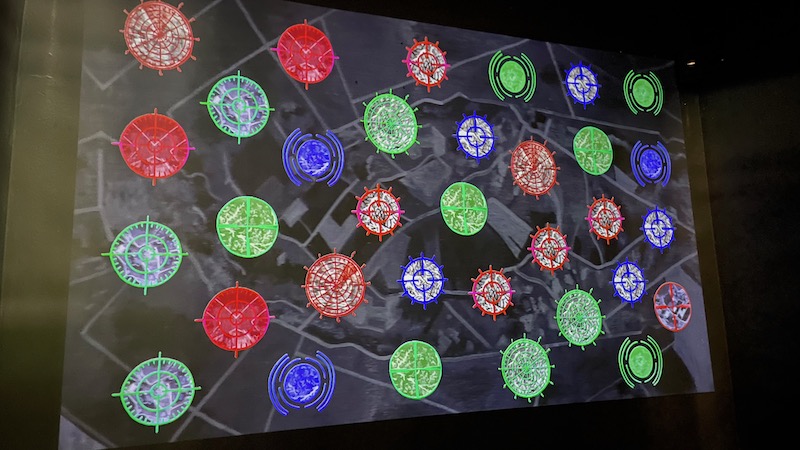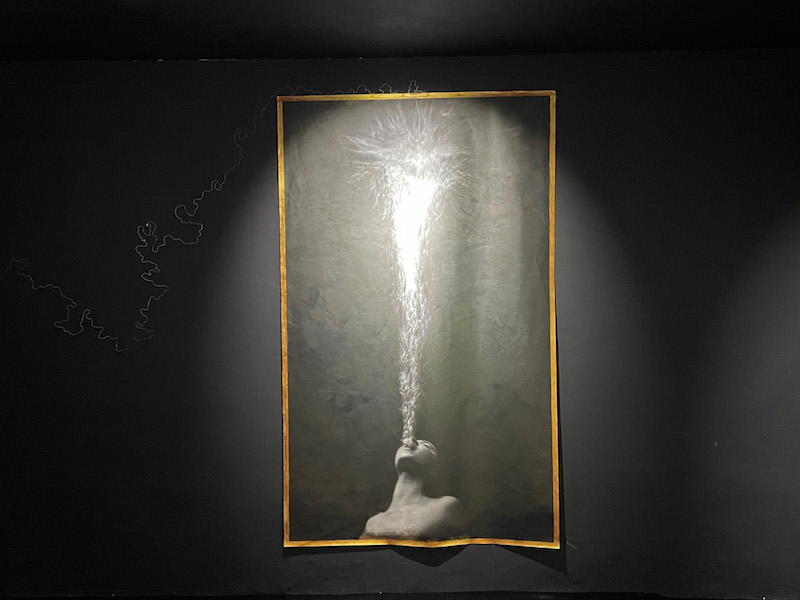by Sean Smuda // Nov. 15, 2024
The 15th Dakar Biennale, ‘The Wake,’ takes place in the Ancien Palais de Justice near the western-most point of the continent. Completed just prior to French decolonization in 1958, its location and scale are otherworldly. The non- Archimedean, naturally ventilated structure is an ideal vantage from which to reflect on form and identity as sentences that must be carried out and rewritten until they are free. The exhibition holds the multiplicities that its title suggests, towards cross-pollinations, drawn in part from Christina Sharpe’s 2016 book ‘In the Wake: On Blackness and Being.’ To cast a few: they are celebration, memory, enlightenment, pain and wisdom—an organic Realpolitik.

Gina Athéna Ulysse: ‘For Those Among Us Who Inherited Sacrifice, Rasanblaj!,’ installation view at Dakar Biennale 2024 // Copyright the artist, photo by Sean Smuda
‘The Wake’ begins with a giant wall of calabash and shells outside the entrance. ‘For Those Among Us Who Inherited Sacrifice, Rasanblaj!’ by Haitian-American artist Gina Athéna Ulysse evokes sifting and gathering from oceans that unite and separate, according to the definition of rasanblaj: a grouping of ideas, things, people, spirits, a gathering, a ceremony, a protest. From a sea bed of stones, the visitor looks up to a vertical wake that carries oxygen bubble shells and tribute baskets. If social and climate change are to be believed as epochal, it is too late for the Anthropocene and we must adapt to warming and inundation—ritualize bunker, code, environment and economic buffers on the way to final oceanic surrender and oneness. Extinction comes in waves. On the other side of the door, however, is the 1.5-meter-high ‘Masai Warrior’ by Ousmane Sow (Senegal), safeguarding memory and identity through whatever permutations may come. The first artist to be admitted to the French Academy of Fine Arts, his massive bronze seems multiplied, with a notable police presence around it and throughout the city. Perhaps they are safeguarding a precarious tradition from the confusion of the recently jailed then newly elected populist government.

Jake Michael Singer: ‘Murmur,’ installation view at Dakar Biennale 2024 // Copyright the artist, photo by Sean Smuda
Inside the open-air, tree-filled courtyard of judgments, ‘Murmur’ by Jake Michael Singer (South Africa) travels upward. A Phoenix made of welding rods and automotive paint, it combines organic and technological flocking as a Promethean process that overcomes its crime. At a two-to-one scale to the viewer, it engulfs eyes and body as they dance around it. The earth-red rods evoke the 1s and 0s of space, motion and a wonder at its endurance and inevitable rust—a frozen motion mandala hood ornament for bio-political automotive longevity.
If we are to accept that it is too late, then Ethiopian-American artist Ezra Wube’s animation ‘The Anthropocene Comedy’ is a Fordist scrapbook of industrial consumption as self-destruction. Its exposition and disintegration of the symbolic order is a naively painted cycle, nostalgic of entropy and rebirth. Yet, the vibe is playful, even as everything is sucked into oblivion to a brighter place. Appropriately, and like many other tech-based works, it wasn’t functioning during the opening and only sporadically thereafter.

Ezra Wube: ‘The Anthropocene Comedy,’ HD video, 29’40”, installation view at Dakar Biennale 2024 // Copyright the artist, photo by Sean Smuda
Several exhibition texts mention the novella ‘The Deep,’ a 2019 fantasy book by Rivers Solomon, with Daveed Diggs, William Hutson and Jonathan Snipes that depicts an underwater society built by the water-breathing descendants of pregnant slaves, thrown overboard on the trans-Atlantic passage. In ‘Réparer la Mer (Repair the Sea),’ Sidney Régis (Martinique/France) takes a passion for free diving (up to 100m) to breathe within this environment. Here, the body loses its air volume and circular breathing based on Tibetan meditation is employed. Extending this mindful approach, the title is minutely, repeatedly inked onto maps. It is accompanied by a pre-Platonic mystery shape that is revealed to be the enfolded continents, lest the diver forget where they come from. Large, underwater black-and-white photos, reworked with the same ink, exhale powerfully towards this surface and set an evolutionary consciousness into the destructive, polluting pain of history.

Sidney Régis: ‘Réparer la Mer (Repair the Sea),’ installation view at Dakar Biennale, 2024 // Copyright the artist, photo by Sean Smuda
Bringing it all back home to a doucement, doucement (easy, easy) present is the homage (or femage) to Senegalese artist Anta Germaine Gaye. A living treasure, in the Japanese and ‘Alice in Wonderland’ caterpillar tradition, the artist is present and so is her bedroom/lounge. Traditional souwere paintings (under glass) and sculptural tableaux spread with tree roots in an open air courtyard—the outside of a lush inside. Colonial-resistant and Sufi scrying mirrors give a soap-operatic, psychedelic hit to their domesticity. With its slow, dreamy, half-awake gaze, the work is a potent potion of a presence on its own course, between waves.
The exhibition seems to ask: is there art that can transcend its roots or can it only be transformed through water? The increasing prescription, monetized or not, of everything including memory, from generation to generation, is here split wide open, and the potential for seeing through the welling eyes of others, as one of the most natural things, is presented as a supreme road to justice at ‘The Wake.’
Exhibition Info
Biennale de Dakar
Group Show: ‘The Wake’
Exhibition: Nov. 7-Dec. 7, 2024
biennaledakar.org
Palais De Justice, Dakar, Senegal, click here for map




















